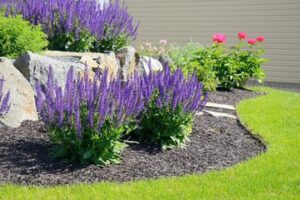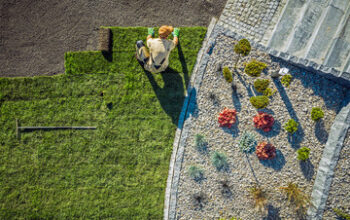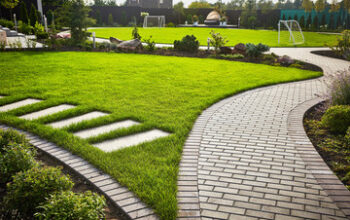Landscaping Boynton Beach is a great way to add value to your property. It creates curb appeal, which can help you sell your home faster.
It can also increase your home’s comfort and privacy. It involves a mix of natural elements and hardscapes like walkways, patios, and decks. The most important element of landscape design is color, but form and texture are also crucial.
The use of color is important in landscaping, because it can enhance the overall aesthetic of a property. It’s also a key element in creating a harmonious relationship between the structure of a home or office building and its surrounding environment.
Different architectural styles lend themselves to certain colors, and it’s important to coordinate them accordingly. For example, soft pastels can complement a traditional colonial house, while bolder hues may work better for modern designs.
Landscaping companies often offer seasonal color programs, which allow clients to add a pop of color in their gardens and on their porches throughout the spring and fall. These are popular because they can create an instant visual impact.
When choosing a color palette, it’s important to consider the types of plants and trees that are in your garden or landscape. For instance, woodsy tones pair well with flowering perennials like black eyed susans and Colorado gold gazanias. Brighter colors, such as petunias and dahlias, can also complement your landscape and provide a splash of vibrant color. For the most cohesive look, try blending your flowers with softer foliage or mulch tones.
Form
The shape and form of your landscape is a critical element in designing beautiful spaces. There is a debate over whether you should prioritize function (the practical usability of a space) or form (the visual and emotional impact of the design). The most successful landscapes are those that balance both functions and forms, creating stunning outdoor spaces that serve their purpose while making people happy.
Form is determined by the shape and arrangement of plants and trees. The varying forms of a garden can create a sense of structure and order, or they can evoke a more natural, relaxed atmosphere. For example, sheared boxwoods can add a formal character to the garden, while loose rhododendrons can give a more organic feel.
Lines are another important factor in form, determining how the eye moves through the landscape. Straight lines tend to have a more structured, formal character and are often associated with symmetry. Curved lines, on the other hand, create a more organic, natural character and are often found in softscape elements like lawns or planting beds.
Scale is also an important aspect of form, determining the size and proportion of elements in a landscape. Larger scale creates a sense of grandeur and dominance, while smaller scale provides intimacy and cohesion.
Texture is the visual and tactile quality of a surface, ranging from smooth to rough. It is often used in combination with color and form to create contrast and intrigue. For example, mixing fine textures (like ferns and baby’s breath) with coarse textures (like lava rock and river gravel) can create an interesting juxtaposition.
Unity is an important aspect of the overall design, establishing a theme and creating consistency across the landscape. The use of color, lines, form, texture and scale can help achieve this, ensuring that all the elements are connected in some way.
Lines
Lines are pathways for the eye to follow and can help direct your landscape design by drawing attention to a focal point or opening up new views. They can also make gardens of any size feel more expansive and connect the inside of homes to the outdoors. There are many ways to incorporate lines into your garden, including planting along property lines, creating a linear path, or using low garden walls and walkways to create horizontal lines.
There are three primary types of lines used to draw forms in a landscape: plant lines, hardscape lines and architectural lines. Plant lines are created where the edge of a plant or groundcover meets another surface material such as turf, gravel, patio pavers or soil. Hardscape lines are the edges of built features like fences and walls, while architectural lines are the vertical forms of building elements and plant materials.
Straight lines create a formal character and are often associated with symmetry and balance. They tend to have a rigid, structural appearance and lead the eye directly toward a focal point. Curved lines are more natural and relaxed, and they can add interest to a landscape by softening the sharpness of straight lines.
Horizontal lines move the eye along the ground plane and can make a garden feel larger. They can also tie spaces together or spatially divide them. Garden walls, walkways and short hedges are good examples of horizontal lines.
Vertical lines make a garden feel taller and full of movement. They can accentuate a focal point and create a sense of drama. Arbors, trees and upright plant material are good examples of vertical lines.
Slightly wavy or meandering lines are also common in landscaping, as they reflect the movement of water and other natural features. These lines can be found in rock gardens, dry stream beds and purposely-created paths.
Space
A well-designed landscape not only accentuates your property’s beauty, but also provides practical benefits like increased property value and reduced energy costs. Achieving these objectives requires a keen understanding of the basic elements of landscape design and their application to the specifics of your property.
The art of landscaping goes beyond planting trees and shrubs to include the construction of hardscape structures like patios, pathways, and decks. Additionally, it includes altering the terrain of your outdoor spaces by grading and shaping the land for aesthetics or usability purposes.
Focal points are the centerpieces of a landscape, captivating your attention and evoking emotions through their visual appeal. They can take the form of water features, eye-catching sculptures, or thoughtfully placed plantings. Choosing focal point components that resonate with your aesthetic and style preferences will ensure that the resulting outdoor space is harmoniously balanced and beautiful.
Scale and proportion are essential considerations in any landscape layout. They play a vital role in creating balance and harmony in your landscape by drawing the eye from one element to another. The size of your home, garden beds, and other hardscape features should be taken into account when determining the scale of the overall landscape design. For example, a small patio should not be dwarfed by your home or overwhelmed by a large tree. It’s also important to balance the use of repetitive and new elements. Repetition can provide unity and cohesion, but it can become monotonous if overused.
The landscape design process can be daunting, especially if you’re not familiar with the nuances of the various elements. Luckily, professional landscapers have the experience and knowledge to guide you through the process. They will consider the unique characteristics of your space, including soil conditions, sunlight exposure, and climate, to create a beautiful and functional outdoor environment.
Taking the time to understand these principles will help you design and construct a landscape that stands the test of time. With climate patterns shifting, it’s more important than ever to design a sustainable landscape that can withstand the tests of drought and flood. This will reduce your carbon footprint and save you money in the long run by reducing chemical inputs, watering needs, and yard maintenance.



